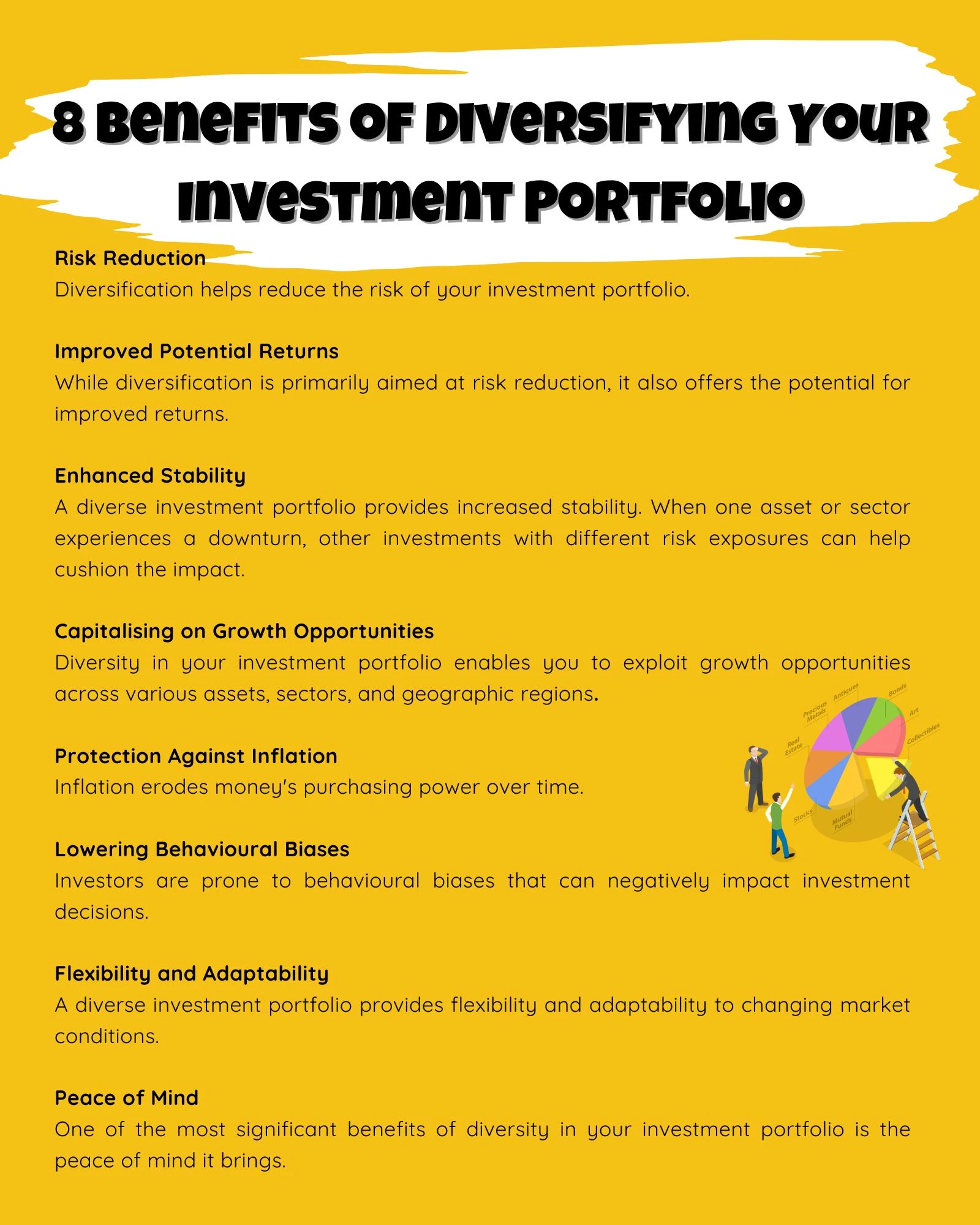- Table of Contents
- Introduction
- Understanding Diversification in Investing
- Types of Diversity in an Investment Portfolio
- Asset Class Diversity
- Sector Diversity
- Geographic Diversity
- 8 Benefits of Diversifying Your Investment Portfolio
- Risk Reduction
- Improved Potential Returns
- Enhanced Stability
- Capitalising on Growth Opportunities
- Protection Against Inflation
- Lowering Behavioural Biases
- Flexibility and Adaptability
- Peace of Mind
- Modern Portfolio Theory and Diversification
- Cryptocurrency and Alternative Investments
- 1- Cryptocurrency
- 2- Alternative Investments
- Balancing Act: Integrating Cryptocurrency and Alternatives
- Socially Responsible Investing (SRI)
- Understanding Socially Responsible Investing (SRI)
- Benefits of Socially Responsible Investing (SRI)
- Implementing Socially Responsible Investing (SRI) in a Diversified Portfolio
- Challenges and Considerations in Socially Responsible Investing (SRI)
- Conclusion
Introduction
Investing is an essential tool for individuals seeking financial security and growth. As the investment landscape continues to evolve, it is becoming increasingly important to understand the concept of diversification and the benefits it offers. Diversifying your investment portfolio involves spreading your investments across various assets and sectors to reduce risk and maximise potential returns. However, diversity in your investment portfolio extends beyond just asset allocation. This blog post will delve into the importance of diversity in investment portfolios, explore different types of diversity, and highlight the eight significant benefits it brings.
Understanding Diversification in Investing
Diversification is a strategy that aims to mitigate risk by spreading investments across multiple assets. Investing in a diverse range of assets can reduce the impact of any individual investment's poor performance on your overall portfolio. The primary principle behind diversification is to avoid putting all your eggs in one basket. It helps to protect your portfolio from volatility and unexpected market fluctuations.
Types of Diversity in an Investment Portfolio
While asset allocation diversification is crucial, broadening our perspective and considering various types of diversity within an investment portfolio is essential. Let's explore three key types of diversity:
Asset Class Diversity
Investors often diversify their portfolios across various asset classes, including stocks, bonds, commodities, real estate, and cash equivalents. Each asset class carries its own set of risk and return characteristics. By combining these different asset classes, investors can balance risk exposure and potentially enhance their overall returns.
Asset Class | Risk Level | Potential Return |
Stocks | High | High |
Bonds | Moderate | Moderate |
Real Estate | Moderate | Moderate |
Commodities | High | High |
Cash Equivalents | Low | Low |
Table 1: Assets you could invest in
Sector Diversity
Sector diversity refers to investing in companies across different industries or sectors, such as technology, healthcare, finance, consumer goods, and energy. Each sector performs differently depending on market conditions, economic factors, and consumer trends. By allocating investments across various sectors, you can benefit from the growth potential of different industries while reducing the risk associated with a single sector's underperformance.
Geographic Diversity
Geographic diversity involves investing in companies and markets across different regions and countries. Global markets can exhibit significant variations in performance due to regional economic factors, political stability, and currency fluctuations. Investing in diverse geographic regions can mitigate the impact of adverse events in a single market and capitalise on growth opportunities worldwide.
8 Benefits of Diversifying Your Investment Portfolio
Now that we understand the importance of diversification in an investment portfolio, let's delve into the eight key benefits it brings, empowering you to make informed decisions and maximise the potential of your investments:

Risk Reduction
Diversification helps reduce the risk of your investment portfolio. By spreading your investments across different assets, sectors, and geographic regions, you can decrease the impact of market volatility and minimise potential losses. This risk reduction is particularly crucial during times of economic uncertainty or market downturns. According to Bankrate, however, while diversification effectively mitigates asset-specific risk by reducing overexposure to a single stock or a particular asset class like stocks, it is important to note that it does not completely eliminate market risk, which is inherent in owning any type of asset.
Improved Potential Returns
While diversification is primarily aimed at risk reduction, it also offers the potential for improved returns. Investing in various assets with different risk and return profiles increases the likelihood of capturing positive performance across different market conditions, potentially enhancing overall investment returns over the long term.
Enhanced Stability
A diverse investment portfolio provides increased stability. When one asset or sector experiences a downturn, other investments with different risk exposures can help cushion the impact. This stability allows you to weather market fluctuations and maintain a more balanced portfolio.
Capitalising on Growth Opportunities
Diversity in your investment portfolio enables you to exploit growth opportunities across various assets, sectors, and geographic regions. Different markets and industries go through cycles of growth and contraction at different times. By diversifying, you position yourself to benefit from the expansion of successful companies and emerging markets.
Protection Against Inflation
Inflation erodes money's purchasing power over time. Diversification can act as a hedge against inflation by including assets that tend to perform well during inflationary periods, such as real estate or commodities. These assets can help preserve wealth and maintain its value in times of rising prices.
Lowering Behavioural Biases
Investors are prone to behavioural biases that can negatively impact investment decisions. One common bias is the tendency to chase performance by investing heavily in one asset class or sector that has recently outperformed. Diversification helps mitigate these biases by spreading investments across different assets, preventing overexposure to any single investment.
Flexibility and Adaptability
A diverse investment portfolio provides flexibility and adaptability to changing market conditions. If one asset class or sector underperforms, you can rebalance your portfolio and reallocate funds to better-performing investments. This flexibility allows you to adapt to evolving market trends and adjust your portfolio accordingly.
Peace of Mind
Perhaps one of the most significant benefits of diversity in your investment portfolio is the peace of mind it brings. Knowing that your investments are spread across different assets, sectors, and geographic regions can instil confidence and help you stay focused on your long-term investment goals. This peace of mind allows you to navigate market uncertainties without succumbing to panic or impulsive decision-making.
Modern Portfolio Theory and Diversification
A cornerstone of diversification in investment portfolios is the application of Modern Portfolio Theory (MPT). Developed by Nobel laureate Harry Markowitz in the 1950s, MPT provides a framework for constructing portfolios that aim to optimise the trade-off between risk and return.
At the heart of MPT is the concept of efficient frontier, which represents the set of portfolios that offer the highest expected return for a given level of risk, or conversely, the lowest risk for a given level of expected return. Diversification is crucial in achieving an optimal portfolio along the efficient frontier.
MPT recognises that an individual asset's risk should not be evaluated in isolation but rather in the context of its contribution to the overall portfolio risk. By combining assets with different risk and return characteristics, MPT suggests that investors can achieve a more efficient portfolio that balances risk and potential reward.
MPT advocates diversification, which aims to reduce portfolio volatility by selecting assets with low or negative correlation with each other. Assets with low correlation tend to move independently or in opposite directions, which helps offset the impact of market fluctuations and create a more stable portfolio.
Investors can improve their risk-adjusted returns by diversifying across different asset classes, sectors, and geographic regions. MPT emphasises the importance of considering an investment's risk and return characteristics not only in isolation but also in relation to the entire portfolio. This approach helps investors achieve a better balance between risk and reward, maximising the benefits of diversification.
It is worth noting that MPT assumes that investors are rational and risk-averse, seeking to optimise their portfolios based on expected returns and volatility. However, real-world markets can deviate from these assumptions due to behavioural biases, market inefficiencies, and unforeseen events. Therefore, while MPT provides a valuable framework, it is important to adapt its principles to individual circumstances and remain vigilant in portfolio management.
In summary, Modern Portfolio Theory provides a solid foundation for understanding the role of diversification in investment portfolios. By combining assets with different risk and return profiles, diversification allows investors to construct portfolios that maximise returns while managing risk. Integrating the principles of MPT into investment strategies can help individuals achieve more robust and efficient portfolios.
Cryptocurrency and Alternative Investments
As the investment landscape evolves, the rise of cryptocurrency and alternative investments introduces a dynamic dimension to the traditional diversification strategy. Investors seeking to broaden their portfolios are increasingly exploring these unconventional assets to enhance diversification, although this comes with unique challenges and opportunities.
1- Cryptocurrency
With Bitcoin leading the way, cryptocurrency has garnered significant attention in recent years. Including digital assets in an investment portfolio offers a form of diversification that operates outside the traditional financial markets. Here are some key considerations and potential benefits of integrating cryptocurrency into a diversified portfolio:
i) Decentralisation and Non-Correlation
Cryptocurrencies operate on decentralised blockchain technology, making them less susceptible to the influences of traditional financial markets. The non-correlation with traditional assets means that the value of cryptocurrencies may not necessarily move in tandem with stocks or bonds, providing a potential hedge against market downturns.
ii) Volatility and Risk
While cryptocurrencies offer diversification benefits, it's crucial to acknowledge their inherent volatility. The value of digital assets can experience significant fluctuations over short periods. Investors should carefully assess their risk tolerance and overall portfolio strategy before allocating some of their investments to cryptocurrencies.
iii) Long-Term Growth Potential
Despite volatility, some investors view cryptocurrencies as a long-term investment with the potential for substantial growth. The limited supply of certain cryptocurrencies, like Bitcoin, contributes to their perceived scarcity, potentially driving value over time.
iv) Portfolio Allocation
Integrating cryptocurrency into a diversified portfolio requires thoughtful allocation. Due to the higher risk associated with digital assets, a modest allocation may be appropriate for risk-averse investors. Others with a higher risk tolerance may opt for a more significant allocation, considering the potential for outsized returns.
2- Alternative Investments
Beyond cryptocurrency, alternative investments encompass a broad category of non-traditional assets that can contribute to portfolio diversification. These may include private equity, hedge funds, real assets (such as precious metals or artwork), and venture capital. Here's an exploration of the role of alternative investments in diversification:
i) Reducing Correlation
Alternative investments often exhibit a lower correlation with traditional asset classes, providing an opportunity to reduce overall portfolio risk further. Although their performance may not align with the broader market, they offer a hedge during periods of market turbulence.
ii) Access to Unique Opportunities
Alternative investments provide access to unique opportunities that may not be available in traditional markets. Private equity, for example, allows investors to participate in the growth of private companies before they go public, potentially generating higher returns.
iii) Illiquidity and Due Diligence
Acknowledging the potential downsides of alternative investments, such as illiquidity, is essential. Unlike publicly traded stocks and bonds, some alternative assets may have limited liquidity, meaning converting them into cash quickly could be challenging. Thorough due diligence is crucial to understanding each alternative investment's risks and potential rewards.
iv) Diversification Across Market Cycles
Alternative investments often perform differently across various market cycles. This diversity in performance can contribute to a more resilient portfolio that adapts to changing economic conditions.
Balancing Act: Integrating Cryptocurrency and Alternatives
While both cryptocurrency and alternative investments offer diversification benefits, finding the right balance is key. Each investor's risk tolerance, investment goals, and time horizon will influence the optimal allocation of these assets within their portfolio.
Asset Class | Risk Level | Potential Return | Correlation with Traditional Markets | Considerations |
Cryptocurrency | High | High | Low | Consider risk tolerance, long-term perspective, and modest allocation. |
Alternative Investments | Varies | Varies | Low | Evaluate illiquidity, unique opportunities, and potential correlation benefits. |
Table 2: Cryptocurrency and Alternative Investments Allocation Guide
Investors should approach these alternative assets with a clear understanding of their risk-return profiles and the impact they may have on overall portfolio dynamics. As the cryptocurrency and alternative investment landscape evolves, staying informed and adapting to market trends will be essential for successful integration into a diversified investment strategy.
Socially Responsible Investing (SRI)
In the ever-evolving landscape of investment, Socially Responsible Investing (SRI) has emerged as a compelling approach that integrates financial goals with ethical considerations. SRI, or sustainable or ethical investing, goes beyond traditional financial metrics, considering environmental, social, and governance (ESG) factors. This section explores the nuances of SRI and how it contributes to the diversification of investment portfolios.
Understanding Socially Responsible Investing (SRI)
Environmental Considerations
SRI considers the environmental impact of investments, focusing on companies that demonstrate eco-friendly practices. This may include businesses committed to sustainability, renewable energy, or reducing carbon footprints. Investors seek to align their portfolios with environmentally responsible initiatives to contribute positively to the planet.
Social Impact
The social component of SRI evaluates how companies treat their employees, engage with communities, and contribute to societal well-being. Investors favour companies with fair labour practices, diverse and inclusive workplaces, and a commitment to social responsibility. This aspect of SRI aims to foster positive societal change through investment choices.
Governance Practices
Governance refers to the structures and processes that guide corporate decision-making. SRI assesses companies based on factors such as transparent leadership, ethical business practices, and board accountability. Investors employing SRI principals look for companies with strong governance, believing that well-managed entities are more likely to deliver sustainable returns.
Benefits of Socially Responsible Investing (SRI)
Aligning Values with Investments
One of the primary benefits of SRI is the ability to align personal values with investment decisions. Investors can support causes they believe in, contributing to positive societal and environmental change through their investment choices.
Mitigating Risk
Companies with robust ESG practices are often better equipped to manage risks associated with environmental disasters, social controversies, or governance issues. Therefore, SRI provides a risk-mitigation strategy by emphasising investments in companies with responsible and sustainable business practices.
Long-Term Sustainability
SRI encourages a focus on long-term sustainability of investments. By investing in companies that prioritise environmental and social responsibility, investors contribute to building a more sustainable and resilient economy over time.
Implementing Socially Responsible Investing (SRI) in a Diversified Portfolio
SRI Mutual Funds and ETFs
Investors interested in SRI can explore mutual funds and exchange-traded funds (ETFs) specifically designed with ESG criteria in mind. These funds pool together investments in companies that meet certain sustainability standards, providing an easy entry point for those looking to integrate SRI into their portfolios.
Direct Stock Selection
For a more hands-on approach, investors can directly select individual stocks based on their adherence to SRI principles. Thorough research into companies' ESG practices is essential for making informed decisions that align with one's values.
Impact Investing
Impact investing takes SRI a step further by actively seeking opportunities to generate positive social and environmental impact alongside financial returns. This could involve investing in companies directly involved in addressing global challenges, such as clean energy initiatives or affordable housing projects.
Challenges and Considerations in Socially Responsible Investing (SRI)
Subjectivity in ESG Criteria
Evaluating companies based on ESG criteria can be subjective, and different investors may prioritise different factors. It's essential for investors to clearly define their values and priorities when incorporating SRI into their portfolios.
Potential Trade-Offs
While SRI aims to align values with investments, there may be trade-offs between financial returns and adherence to strict ESG criteria. Investors must find a balance that suits their financial goals and ethical considerations.
Limited Diversification in Certain Sectors
Some industries may have limited options for companies with strong ESG practices, potentially affecting portfolio diversification. This emphasises the importance of thorough research and careful selection in SRI.
As corporate responsibility continues to grow in importance, SRI is gaining traction as a mainstream investment strategy. Its integration into diversified portfolios reflects a commitment to ethical investing and contributes to the broader goal of building a sustainable and socially conscious financial ecosystem. SRI allows investors to make a positive impact while seeking financial returns, adding a valuable layer to the multifaceted strategy of portfolio diversification.
Conclusion
Diversity in your investment portfolio is not just a buzzword but a fundamental strategy for achieving financial stability and growth. By diversifying across different assets, sectors, and geographic regions, you can reduce risk, enhance potential returns, and navigate market fluctuations confidently. The benefits of diversity extend beyond financial gains and provide stability, flexibility, and peace of mind. Embrace diversity in your investment portfolio and unlock its potential to secure your financial future.
In your journey towards mastering the art of portfolio diversification and asset management, consider enrolling in our comprehensive course, ‘Portfolio & Asset Management.’ This course will equip you with the skills and knowledge needed to craft a well-balanced and diversified investment portfolio. Learn the intricacies of asset allocation, explore the nuances of different investment types, and understand how to optimise your portfolio for risk and return. Gain insights from industry experts, delve into real-world case studies, and emerge confident to make informed investment decisions. Elevate your financial acumen and take control of your future by enrolling in our Portfolio & Asset Management course today. Your path to financial success begins with mastering the principles of diversification, and we're here to guide you every step of the way.
























